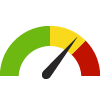Economic Wellbeing
A thriving economy provides jobs, income for necessities, and sufficient revenue for public services, creating a flourishing community for people and businesses. Strong economic resources allow individuals to possess workforce skills for success, businesses to be more productive, families to be more self-reliant, and government to be responsive to citizen priorities.
Strong employment growth and revitalization are signs of, and contribute to, a healthy economy, while employment by sector indicates a diverse economy, and higher wages make the region more affordable for residents to be self-sufficient.
The employment-to-population ratio is an alternative measure to unemployment, capturing the unemployed who leave the labor market over time because their state unemployment benefits run out, they weren't eligible or never applied for benefits, or they stopped looking for work. The duration of decline overtime is an indication of job growth needed to return to pre-downturn levels.
The unemployment rate measures the percentage of the labor force that is unemployed, based upon a monthly Bureau of Labor Statistics (BLS) household survey, but it does not show people who are no longer looking for work or are under-employed. Employment is measured separately via different BLS payroll and business surveys.
Job creation programs and workforce development impact job creation, while unemployment shows how many people are having difficulty getting jobs. Higher unemployment rates may reflect those no longer able to collect unemployment or find work. Lower rates can be related to seasonal employment (minimum wage seasonal retail jobs have limited long-term impact on the local economy). California also impacts economic factors in Nevada.
Questions remain as to how many jobs at varying levels, skills and wages are needed to spur our economy, in consideration of population changes and new entrees to the job market. To stimulate the economy, higher wage jobs are needed.
While gaming and tourism have historically been the centerpieces of the region’s economy, efforts to diversify and capitalize on market and technological innovations are making headway.
The Cost of Living Index compares living costs for the typical middle-class family, and keeping it close to the national average helps economic development organizations bring quality jobs to the region.
The Cost of Living Index compares living costs (such as housing, transportation, utilities, groceries, and healthcare) for the typical middle-class family. Visit the Basic Family Calculator measure to learn more about what it really costs to live in the Reno-Sparks MSA (Metropolitan Statistical Area).
Indicator Gauge Icon Legend
Legend Colors
Red is bad, green is good, blue is not statistically different/neutral.
Compared to Distribution
 the value is in the best half of communities.
the value is in the best half of communities.
 the value is in the 2nd worst quarter of communities.
the value is in the 2nd worst quarter of communities.
 the value is in the worst quarter of communities.
the value is in the worst quarter of communities.
Compared to Target
 meets target;
meets target;  does not meet target.
does not meet target.
Compared to a Single Value
 lower than the comparison value;
lower than the comparison value;
 higher than the comparison value;
higher than the comparison value;
 not statistically different from comparison value.
not statistically different from comparison value.
Trend

 non-significant change over time;
non-significant change over time; 
 significant change over time;
significant change over time;  no change over time.
no change over time.
Compared to Prior Value
 higher than the previous measurement period;
higher than the previous measurement period;
 lower than the previous measurement period;
lower than the previous measurement period;
 no statistically different change from previous measurement period.
no statistically different change from previous measurement period.
Economic Indicators
Economic Indicators
Air Traffic Passenger Totals Reno-Tahoe International Airport
Air Traffic Passenger Totals Reno-Tahoe International Airport County: Washoe
Air Traffic Passenger Totals Reno-Tahoe International Airport County: Washoe


Air Traffic Cargo Reno-Tahoe International Airport County: Washoe
Air Traffic Cargo Reno-Tahoe International Airport County: Washoe


Artown Economic Impact County: Washoe
Artown Economic Impact County: Washoe


Tax Revenue Distribution County: Washoe
Tax Revenue Distribution County: Washoe


Tax Revenues for Distribution County: Washoe
Tax Revenues for Distribution County: Washoe


Tourism Economic Impact County: Washoe
Tourism Economic Impact County: Washoe


Tourism Occupancy Rate County: Washoe
Tourism Occupancy Rate County: Washoe


Employment and Workforce
Economic Development Assisted New Jobs County: Washoe
Economic Development Assisted New Jobs County: Washoe


Economic Development Assisted New Jobs Average Salary County: Washoe
Economic Development Assisted New Jobs Average Salary County: Washoe


Employer Establishments County: Washoe
Employer Establishments County: Washoe


Employment-to-Population Ratio County: Washoe
Employment-to-Population Ratio County: Washoe


Female Population 16+ in Civilian Labor Force County: Washoe
Female Population 16+ in Civilian Labor Force County: Washoe





Households with Cash Public Assistance Income County: Washoe
Households with Cash Public Assistance Income County: Washoe





Households without a Vehicle County: Washoe
Households without a Vehicle County: Washoe



Employment and Workforce
Households Without Sufficient Net Worth to Subsist at the Poverty Level for 3 Months in the Absence of Income
Households Without Sufficient Net Worth to Subsist at the Poverty Level for 3 Months in the Absence of Income County: Washoe
Households Without Sufficient Net Worth to Subsist at the Poverty Level for 3 Months in the Absence of Income County: Washoe



Labor Force Participation Rate County: Washoe
Labor Force Participation Rate County: Washoe




Population 16+ in Civilian Labor Force County: Washoe
Population 16+ in Civilian Labor Force County: Washoe





Size of Labor Force County: Washoe
Size of Labor Force County: Washoe


Total Employment County: Washoe
Total Employment County: Washoe


Total Employment Change County: Washoe
Total Employment Change County: Washoe






Unemployed Veterans County: Washoe
Unemployed Veterans County: Washoe





Unemployed Workers in Civilian Labor Force County: Washoe
Unemployed Workers in Civilian Labor Force County: Washoe






Unemployment Rate County: Washoe
Unemployment Rate County: Washoe




Income and Spending
Adult Day Care Spending-to-Income Ratio County: Washoe
Adult Day Care Spending-to-Income Ratio County: Washoe





Cost of Living Index Composite Metropolitan Statistical Area (MSA): Las Vegas-Henderson-Paradise
Cost of Living Index Composite Metropolitan Statistical Area (MSA): Las Vegas-Henderson-Paradise


Cost of Living Index Composite Metropolitan Statistical Area (MSA): Reno-Sparks
Cost of Living Index Composite Metropolitan Statistical Area (MSA): Reno-Sparks


Gasoline and Other Fuels Spending-to-Income Ratio County: Washoe
Gasoline and Other Fuels Spending-to-Income Ratio County: Washoe





Income and Spending
Households that are Above the Asset Limited, Income Constrained, Employed (ALICE) Threshold
Households that are Above the Asset Limited, Income Constrained, Employed (ALICE) Threshold County: Washoe
Households that are Above the Asset Limited, Income Constrained, Employed (ALICE) Threshold County: Washoe



Income and Spending
Households that are Asset Limited, Income Constrained, Employed (ALICE)
Households that are Asset Limited, Income Constrained, Employed (ALICE) County: Washoe
Households that are Asset Limited, Income Constrained, Employed (ALICE) County: Washoe



Income Inequality County: Washoe
Income Inequality County: Washoe





Median Household Income County: Washoe
Median Household Income County: Washoe





Median Household Income: Householders 65+ County: Washoe
Median Household Income: Householders 65+ County: Washoe





Cost of Housing Index (CHI) Metropolitan Statistical Area (MSA): Las Vegas-Henderson-Paradise
Cost of Housing Index (CHI) Metropolitan Statistical Area (MSA): Las Vegas-Henderson-Paradise


Cost of Housing Index (CHI) Metropolitan Statistical Area (MSA): Reno-Sparks
Cost of Housing Index (CHI) Metropolitan Statistical Area (MSA): Reno-Sparks


Cost of Housing Index (CHI): Low-income Families Metropolitan Statistical Area (MSA): Las Vegas-Henderson-Paradise
Cost of Housing Index (CHI): Low-income Families Metropolitan Statistical Area (MSA): Las Vegas-Henderson-Paradise


Cost of Housing Index (CHI): Low-income Families Metropolitan Statistical Area (MSA): Reno-Sparks
Cost of Housing Index (CHI): Low-income Families Metropolitan Statistical Area (MSA): Reno-Sparks


Income and Spending
Mortgaged Owners Spending 30% or More of Household Income on Housing
Mortgaged Owners Spending 30% or More of Household Income on Housing County: Washoe
Mortgaged Owners Spending 30% or More of Household Income on Housing County: Washoe






Income and Spending
Older Adult Homeowners Spending 30% or More of Household Income on Housing Costs
Older Adult Homeowners Spending 30% or More of Household Income on Housing Costs County: Washoe
Older Adult Homeowners Spending 30% or More of Household Income on Housing Costs County: Washoe




Per Capita Income County: Washoe
Per Capita Income County: Washoe





Community Spending on Education County: Washoe
Community Spending on Education County: Washoe



College Tuition Spending-to-Income Ratio County: Washoe
College Tuition Spending-to-Income Ratio County: Washoe





Day Care Center and Preschool Spending-to-Income Ratio County: Washoe
Day Care Center and Preschool Spending-to-Income Ratio County: Washoe





Home Child Care Spending-to-Income Ratio County: Washoe
Home Child Care Spending-to-Income Ratio County: Washoe





Student Loan Spending-to-Income Ratio County: Washoe
Student Loan Spending-to-Income Ratio County: Washoe





Income and Spending
Vocational, Technical, and Other School Tuition Spending-to-Income Ratio
Vocational, Technical, and Other School Tuition Spending-to-Income Ratio County: Washoe
Vocational, Technical, and Other School Tuition Spending-to-Income Ratio County: Washoe





Community Spending on Health Care County: Washoe
Community Spending on Health Care County: Washoe



Health Insurance Spending-to-Income Ratio County: Washoe
Health Insurance Spending-to-Income Ratio County: Washoe





Community Spending on Food County: Washoe
Community Spending on Food County: Washoe



Community Spending on Housing County: Washoe
Community Spending on Housing County: Washoe



Community Spending on Transportation County: Washoe
Community Spending on Transportation County: Washoe



Home Renter Spending-to-Income Ratio County: Washoe
Home Renter Spending-to-Income Ratio County: Washoe





Homeowner Spending-to-Income Ratio County: Washoe
Homeowner Spending-to-Income Ratio County: Washoe





Utilities Spending-to-Income Ratio County: Washoe
Utilities Spending-to-Income Ratio County: Washoe





Cigarette Spending-to-Income Ratio County: Washoe
Cigarette Spending-to-Income Ratio County: Washoe







